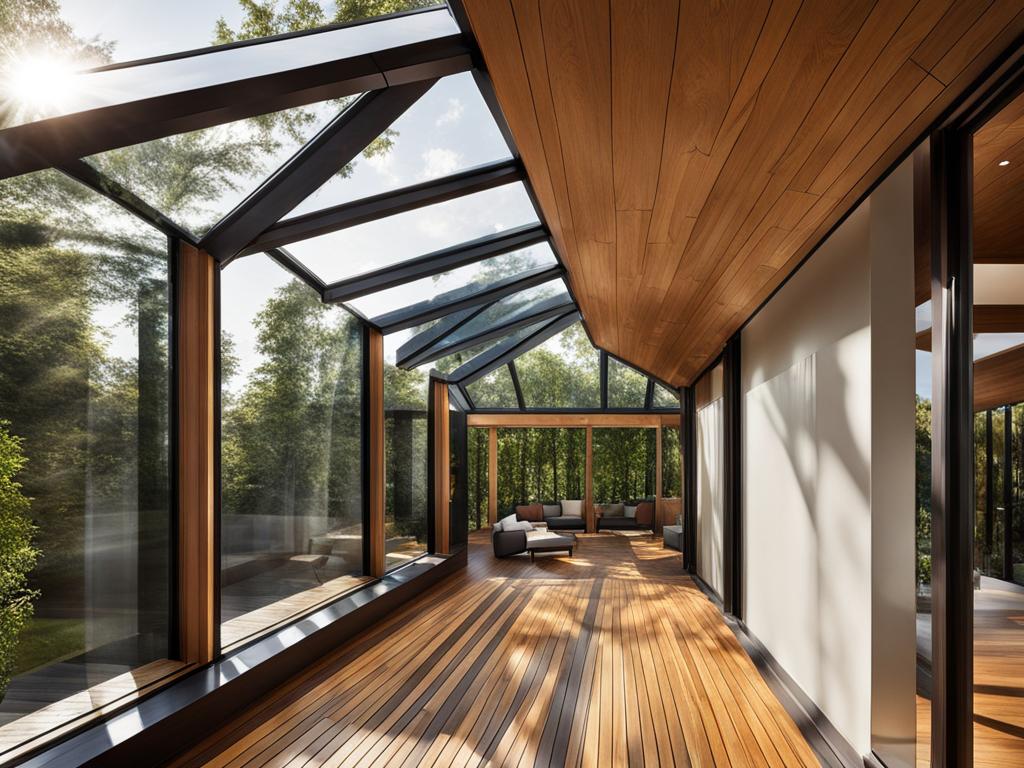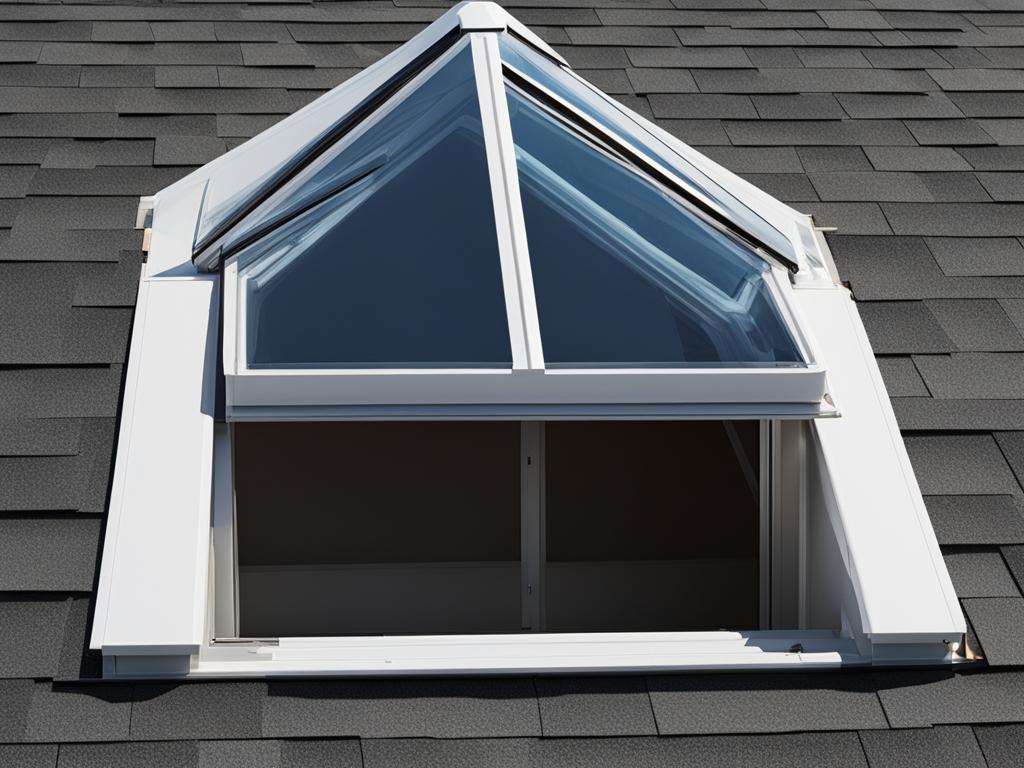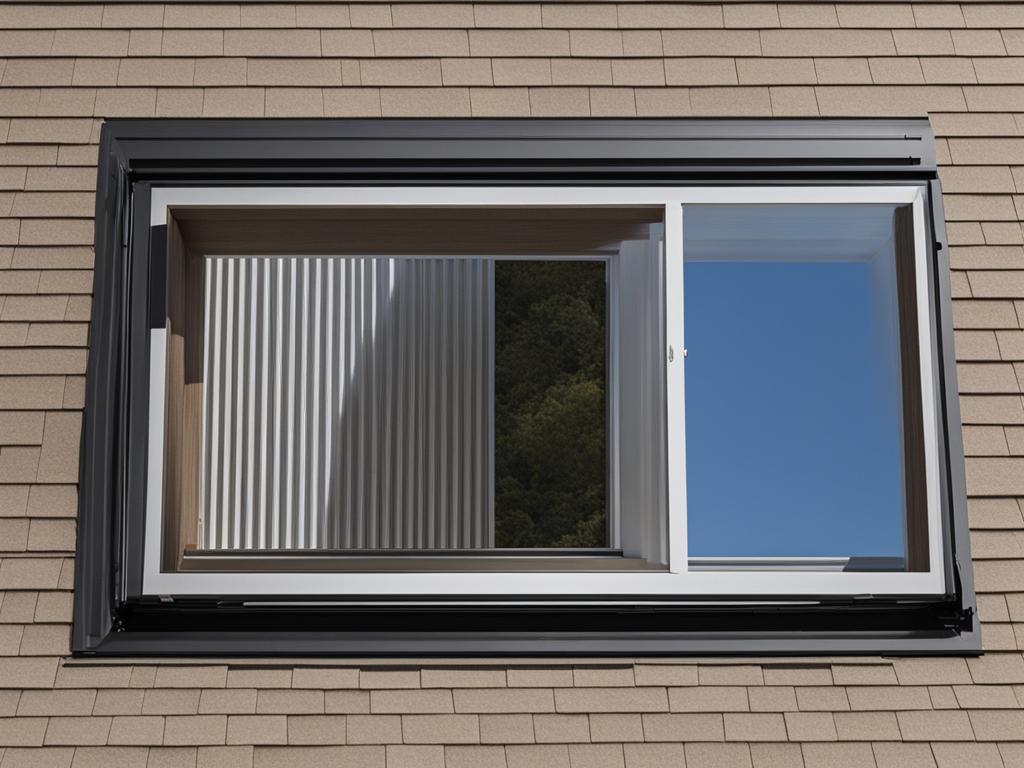Skylights are a popular feature in modern home design, providing natural lighting and enhancing the ambiance of a living space. When it comes to choosing between curb-mounted and deck-mounted skylights, homeowners often find themselves facing a decision. Both options have their advantages, and understanding the differences can help make an informed choice for your home.
Curb-mounted skylights are installed on top of a pre-built curb, which elevates the skylight above the roof’s surface. This design feature allows for effective water drainage and weatherproofing. On the other hand, deck-mounted skylights are directly attached to the roof deck, creating a more streamlined and integrated look.
When it comes to installation, curb-mounted skylights require the construction of a curb, which adds to the installation time and cost. Deck-mounted skylights, on the other hand, are easier to install and may require less labor. The choice between the two depends on your roof type and personal preferences.
Now, let’s take a closer look at the advantages of curb-mounted and deck-mounted skylights:
Key Takeaways:
- Curb-mounted skylights require a pre-built curb, offering versatility and customization options.
- Deck-mounted skylights provide a sleek and integrated look, without the need for a separate curb.
- The installation of curb-mounted skylights involves additional labor and material costs.
- Deck-mounted skylights are easier to install and may reduce overall labor costs.
- The choice between the two depends on roof type, aesthetic preferences, and cost considerations.
Curb-Mounted Skylights
Curb-mounted skylights are a popular choice for homeowners looking to bring natural light into their homes. These skylights are known for their versatility and robust design, making them suitable for various roof types.
To install a curb-mounted skylight, a pre-built curb is required to elevate the skylight above the roof’s surface. The construction of the curb is essential for effective water drainage and weatherproofing.
Once the curb is built, the skylight is fastened onto it using flashing kits, ensuring a watertight seal. This installation method provides superior protection against leaks and enhances the overall durability of the skylight.
Curb-mounted skylights are particularly well-suited for flat roofs or those with a low pitch. They offer a wide range of customization options, allowing homeowners to choose the size, shape, and even the type of glazing that best fits their needs.
However, it’s important to note that the installation of curb-mounted skylights requires additional labor and material costs due to the need for a separate curb. Nevertheless, the benefits of curb-mounted skylights, such as increased natural light and improved ventilation, make them well worth the investment.
Advantages of Curb-Mounted Skylights
- Enhanced natural lighting: Curb-mounted skylights allow for maximum natural light to enter your home, brightening up interior spaces.
- Improved ventilation: With the option to incorporate operable vents, curb-mounted skylights provide excellent ventilation and help maintain a comfortable indoor environment.
- Customization options: Homeowners can choose from various shapes, sizes, and glazing types to meet their aesthetic preferences and energy efficiency goals.
- Long-lasting durability: The robust design and proper installation of curb-mounted skylights ensure durability and resistance to harsh weather conditions.
If you’re considering installing a skylight, curb-mounted skylights offer numerous benefits and can transform the look and feel of your home. Consult with a professional contractor to determine the best option for your specific roof type and design goals.
Deck-Mounted Skylights
Deck-mounted skylights offer a sleek and integrated look, as they are directly attached to the roof deck. They do not require a separate curb and have a lower profile compared to curb-mounted skylights. The installation process involves cutting an opening in the roof deck and fastening the skylight frame directly to it. Deck-mounted skylights are easier to install and offer excellent waterproofing when installed with matching cladding and flashing kits. However, they are more suitable for roofs with a sufficient pitch for proper drainage.
When it comes to advantages, deck-mounted skylights have several benefits. The most notable advantage is their seamless integration with the roof deck, providing an aesthetically pleasing appearance without altering the roof’s silhouette. Additionally, their lower profile enhances the overall aesthetic appeal of the roofline, giving a modern and elegant look to any home.
Installation of deck-mounted skylights is relatively straightforward and can be completed without the need for a separate curb. This simplifies the installation process and reduces labor and material costs. Cutting an opening in the roof deck and securing the skylight frame directly to it ensures a secure and watertight seal.
Deck-mounted skylights also offer excellent waterproofing when installed with the proper cladding and flashing kits. This ensures that the skylight remains resistant to water infiltration, keeping the interior of your home dry and protected.
“Deck-mounted skylights provide a sleek and integrated look, offering numerous advantages such as an enhanced aesthetic appeal, simplified installation process, and excellent waterproofing.”

| Advantages of Deck-Mounted Skylights |
|---|
| Easier installation process |
| Seamless integration with the roof deck |
| Enhanced aesthetic appeal |
| Lower profile design |
| Excellent waterproofing capabilities |
Key Differences Between Curb and Deck Mounted Skylights
When it comes to skylights, choosing between curb-mounted and deck-mounted options can significantly impact both the installation process and the overall aesthetic of your home. Understanding the key differences between these two types is essential in making an informed decision. Let’s take a closer look at the distinctive features of each.
Difference in Installation
- Curb-mounted skylights: These skylights require the construction of a curb on the roof deck. The curb serves as the foundation for the skylight and elevates it above the roof’s surface. The installation process includes building the curb and then attaching the skylight to it using flashing kits for a watertight seal.
- Deck-mounted skylights: These skylights are directly attached to the roof deck without the need for a separate curb. The installation involves cutting an opening in the roof deck and securing the skylight frame directly to it. Matching cladding and flashing kits ensure seamless integration and waterproofing.
Aesthetic Impact
The choice between curb-mounted and deck-mounted skylights can also affect the overall look of your roofline:
Curb-mounted skylights typically have a higher profile and may alter the silhouette of the roof, making them more visible from the exterior. This can add a distinctive architectural element to your home’s design.
On the other hand, deck-mounted skylights offer a lower profile and a more integrated look with the roofline. They blend seamlessly with the roof, creating a sleek and modern appearance.
Determining Factors
When deciding between the two options, consider the following factors:
- The specific roof type and pitch: Curb-mounted skylights are more suitable for flat roofs or those with a low pitch, while deck-mounted skylights require a sufficient pitch for proper drainage.
- Aesthetic preferences: If you prefer a more prominent skylight with architectural impact, curb-mounted skylights may be the better choice. If you prefer a streamlined and integrated look, deck-mounted skylights are likely to align with your vision.
Summary
In summary, the main differences between curb-mounted and deck-mounted skylights lie in their installation process and aesthetic impact. Curb-mounted skylights require the construction of a curb and offer a higher profile, while deck-mounted skylights are directly attached to the roof deck and provide a lower profile. The choice ultimately depends on the specific roof type and personal aesthetic preferences.
| Feature | Curb-Mounted Skylights | Deck-Mounted Skylights |
|---|---|---|
| Installation | Require a pre-built curb on the roof deck | Directly attached to the roof deck |
| Aesthetic Impact | Higher profile, alters roof silhouette | Lower profile, integrates with roofline |
| Suitability | Flat roofs or low-pitched roofs | Roofs with sufficient pitch for drainage |
Skylight Flashing
Flashing is a critical component in skylight installation, ensuring a watertight seal and secure integration with the roofing material. Proper installation of flashing is essential to prevent leaks and maintain the durability of the skylight.
When it comes to skylight flashing, there are specific considerations for both curb-mounted and deck-mounted skylights.
“Flashing is like the armor that protects your skylight from the elements. It ensures that rain and moisture stay outside while allowing natural light to illuminate your space.”
Curb-Mounted Skylight Flashing
Curb-mounted skylights require flashing around the base of the curb to create a tight seal. This flashing acts as a barrier between the skylight and the roof, preventing water from seeping inside. The flashing kits for curb-mounted skylights typically include all the necessary components, such as the base flashing, step flashing, and counter flashing.
The base flashing is installed at the bottom of the curb and serves as the primary waterproofing layer. It is important to ensure that the base flashing is properly sealed to the roof deck to prevent any water penetration.
The step flashing, which is installed along the sides of the curb, provides additional protection against water infiltration. It overlaps the base flashing and diverts any water away from the skylight, helping to keep it dry.
Lastly, the counter flashing is installed over the step flashing and is designed to cover the exposed edges. It acts as a final layer of defense, preventing any water from entering through the sides of the skylight.
Deck-Mounted Skylight Flashing
Deck-mounted skylights require flashing that integrates seamlessly with the roof deck. The flashing kits for deck-mounted skylights are designed to create a watertight seal around the skylight frame.
The flashing is typically installed in layers, starting with the base flashing. This flashing is attached directly to the roof deck and provides the initial barrier against water intrusion. The base flashing should be securely fastened to ensure a tight fit.
Next, step flashing is installed along the sides of the skylight frame, overlapping the base flashing. This step flashing helps divert any water away from the skylight, channeling it down the roof surface.
The final layer of flashing for deck-mounted skylights is the counter flashing, which is installed over the step flashing. The counter flashing protects the exposed edges of the skylight frame and provides an extra layer of defense against water infiltration.
| Flashing | Curb-Mounted Skylights | Deck-Mounted Skylights |
|---|---|---|
| Base Flashing | Installed around the base of the curb | Attached directly to the roof deck |
| Step Flashing | Installed along the sides of the curb | Installed along the sides of the skylight frame |
| Counter Flashing | Installed over the step flashing | Installed over the step flashing |
Table: Comparison of skylight flashing for curb-mounted and deck-mounted skylights.
Proper installation of flashing kits for skylights is crucial for the longevity and performance of the skylight. It is recommended to consult a professional roofing contractor to ensure the flashing is installed correctly, providing maximum protection against water intrusion.

Cost Considerations
The cost of installing skylights is influenced by various factors such as the type of skylight, installation requirements, and labor costs. When comparing curb-mounted and deck-mounted skylights, it’s important to consider both the upfront costs and long-term maintenance expenses.
Curb-Mounted Skylights: Curb-mounted skylights generally have lower upfront costs compared to deck-mounted skylights. However, the installation process for curb-mounted skylights involves building a separate curb, which can add to the overall installation expenses. The additional materials and labor required for constructing the curb should be factored into the total cost.
Building a curb for a curb-mounted skylight can increase the installation costs, but it provides greater flexibility and customization options.
Deck-Mounted Skylights: Deck-mounted skylights may have higher upfront costs, but they are often easier to install, potentially reducing labor costs. Deck-mounted skylights are directly attached to the roof deck without the need for a separate curb. This streamlined installation process can result in reduced labor expenses.
Deck-mounted skylights offer a sleek and integrated look, blending seamlessly with the roofline while potentially saving on labor costs.
It’s important to consider the overall budget when choosing between curb-mounted and deck-mounted skylights. While curb-mounted skylights may have lower upfront costs, the need for a separate curb can increase the overall installation expenses. On the other hand, deck-mounted skylights may have higher upfront costs but can potentially save on labor costs. Assessing both the initial installation expenses and long-term maintenance costs will help in making an informed decision.
Skylight Cost Comparison
| Skylight Type | Cost Range |
|---|---|
| Curb-Mounted Skylights | $500 – $2,500 |
| Deck-Mounted Skylights | $1,000 – $4,000 |
The cost range provided is an estimate and can vary based on factors such as skylight size, glazing type, and additional features. It is recommended to consult with a professional installer to get a more accurate cost estimate based on your specific requirements.
Conclusion
When deciding between curb-mounted and deck-mounted skylights, it is important to consider several key factors. The installation requirements, aesthetic preferences, roof type, and cost all play a significant role in the decision-making process.
Curb-mounted skylights offer versatility and customization options, making them suitable for a wide range of roof types. However, they require the construction of a curb, which can add to the installation costs. On the other hand, deck-mounted skylights provide a sleek and integrated look with the roofline, but they are more suitable for roofs with a higher pitch.
The choice ultimately depends on your specific needs and circumstances. Consulting with a professional roofing and window contractor can provide valuable guidance in selecting the best option for your home. They can assess your roof type, provide expert recommendations, and ensure a seamless installation process.
Considerations such as installation requirements, aesthetic preferences, roof type, and cost should all be carefully evaluated before making a decision. By taking these factors into account, you can choose between curb-mounted and deck-mounted skylights confidently and create a space that is beautifully illuminated with natural light.
FAQ
What are the advantages of curb-mounted skylights?
Curb-mounted skylights offer versatility, customization options, and are suitable for a wide range of roof types. They can be customized to fit the specific needs of your home.
What are the advantages of deck-mounted skylights?
Deck-mounted skylights provide a sleek and integrated look, do not require a separate curb, and have a lower profile compared to curb-mounted skylights.
How is flashing different for curb-mounted and deck-mounted skylights?
Curb-mounted skylights require flashing around the base of the curb, while deck-mounted skylights require flashing that integrates seamlessly with the roof deck.
What are the installation requirements for curb-mounted skylights?
Curb-mounted skylights require a pre-built curb on the roof deck for installation. The construction of the curb is crucial for effective water drainage and weatherproofing.
What are the installation requirements for deck-mounted skylights?
Deck-mounted skylights involve cutting an opening in the roof deck and fastening the skylight frame directly to it. They do not require a separate curb.
What are the main differences between curb-mounted and deck-mounted skylights?
The main differences lie in their installation process and aesthetic impact. Curb-mounted skylights require the construction of a curb on the roof deck, while deck-mounted skylights are directly attached to the roof deck.
How do I choose between curb-mounted and deck-mounted skylights?
The choice depends on various factors, including installation requirements, aesthetic preferences, roof type, and cost. Consulting with a professional contractor can provide valuable guidance.
What are the cost considerations for curb-mounted and deck-mounted skylights?
Curb-mounted skylights generally have lower upfront costs, but the need for a separate curb can add to the overall installation expenses. Deck-mounted skylights may have higher upfront costs but are often easier to install, potentially reducing labor costs.
